Published Oct 3, 2022
Heading Back to Bajor with Nana Visitor
The actress behind Kira Nerys talks her recent appearance on Star Trek: Lower Decks and the legacy of DS9.
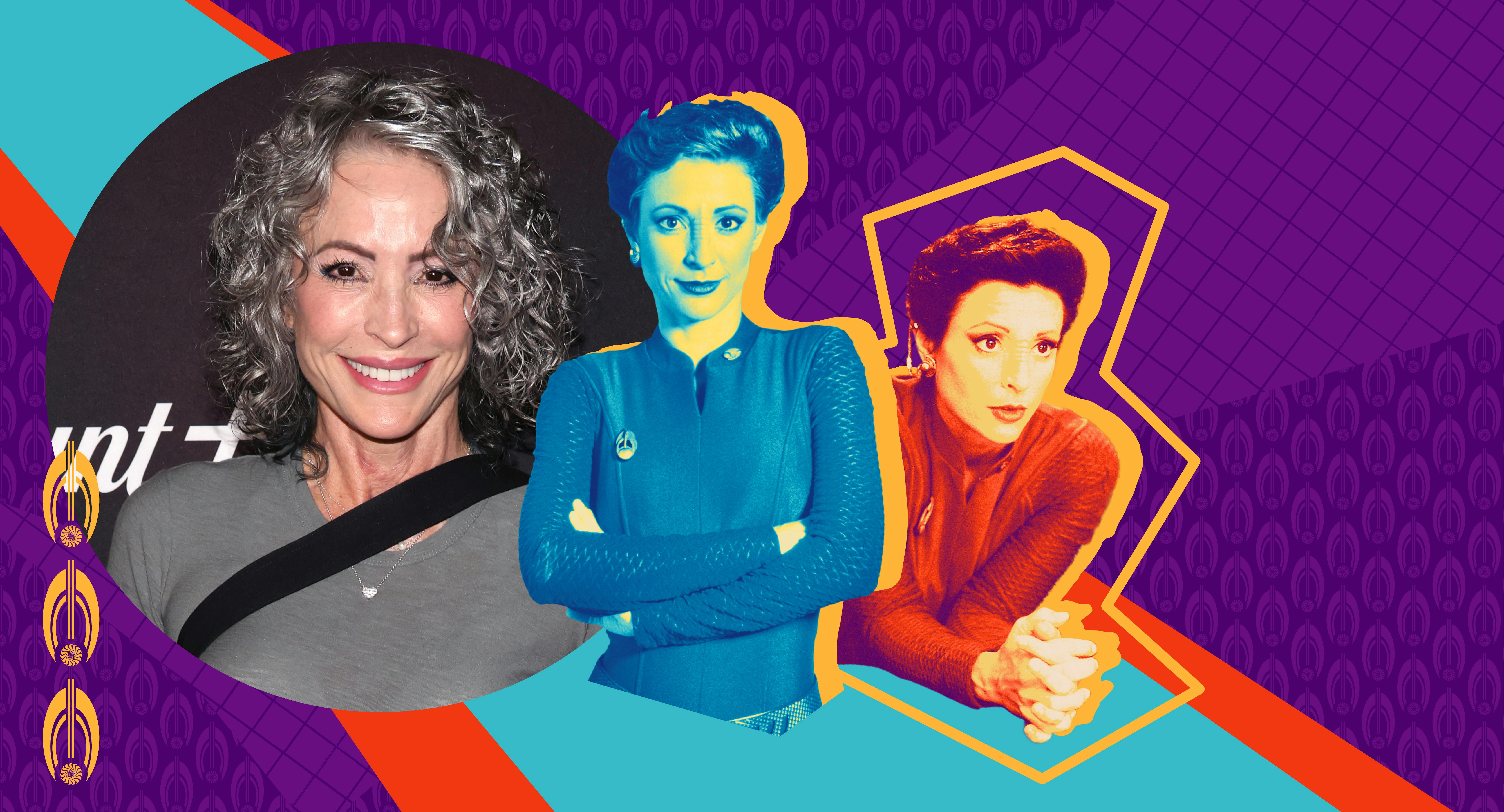
StarTrek.com / Rob DeHart
SPOILER WARNING: Discussion for Star Trek: Lower Decks – Season 3, Episode 6 “Hear All, Trust Nothing” to follow!
When the crew of the U.S.S. Cerritos stopped by Deep Space 9 in the latest episode of Star Trek: Lower Decks, fans were treated to a few familiar faces. There was Quark, of Quark’s Bar franchise fame, and his loyal patron Morn, and of course, there was Colonel Kira Nerys. A Bajoran freedom fighter turned leader, Kira now runs the station as Captain Sisko stays with the Prophets. It’s a far cry from when we first saw her angrily denouncing Starfleet’s arrival in the first episode of Star Trek: Deep Space Nine, and a sign of the immense growth that she underwent over the course of Deep Space Nine’s seven seasons. Also returning to voice the beloved character is actress Nana Visitor. This marks the first time that Visitor has reprised her role in the franchise since the DS9 series finale, "What You Leave Behind." It’s a welcome return for fans of the series and character who are eager to see more of Kira in her post-DS9 life. StarTrek.com sat down with Visitor to discuss Lower Decks, Kira’s journey, and the upcoming 30th anniversary of Deep Space Nine.
StarTrek.com: What was your reaction to learning that the Lower Decks' creators wanted to take fans back to Deep Space Nine, and wanted you to be a part of it?
Nana Visitor: I'll tell you, it really hit me when I saw the episode and I saw the station. It was really emotional to see the station in this new show and hear the music. The joke at the top with the music made me laugh so hard. When it was presented to me, it's like, "Oh, that's interesting and good. I like the show. I like what they're doing. That'll be fun." It was fun, but then when I saw it on television, it was really emotional.
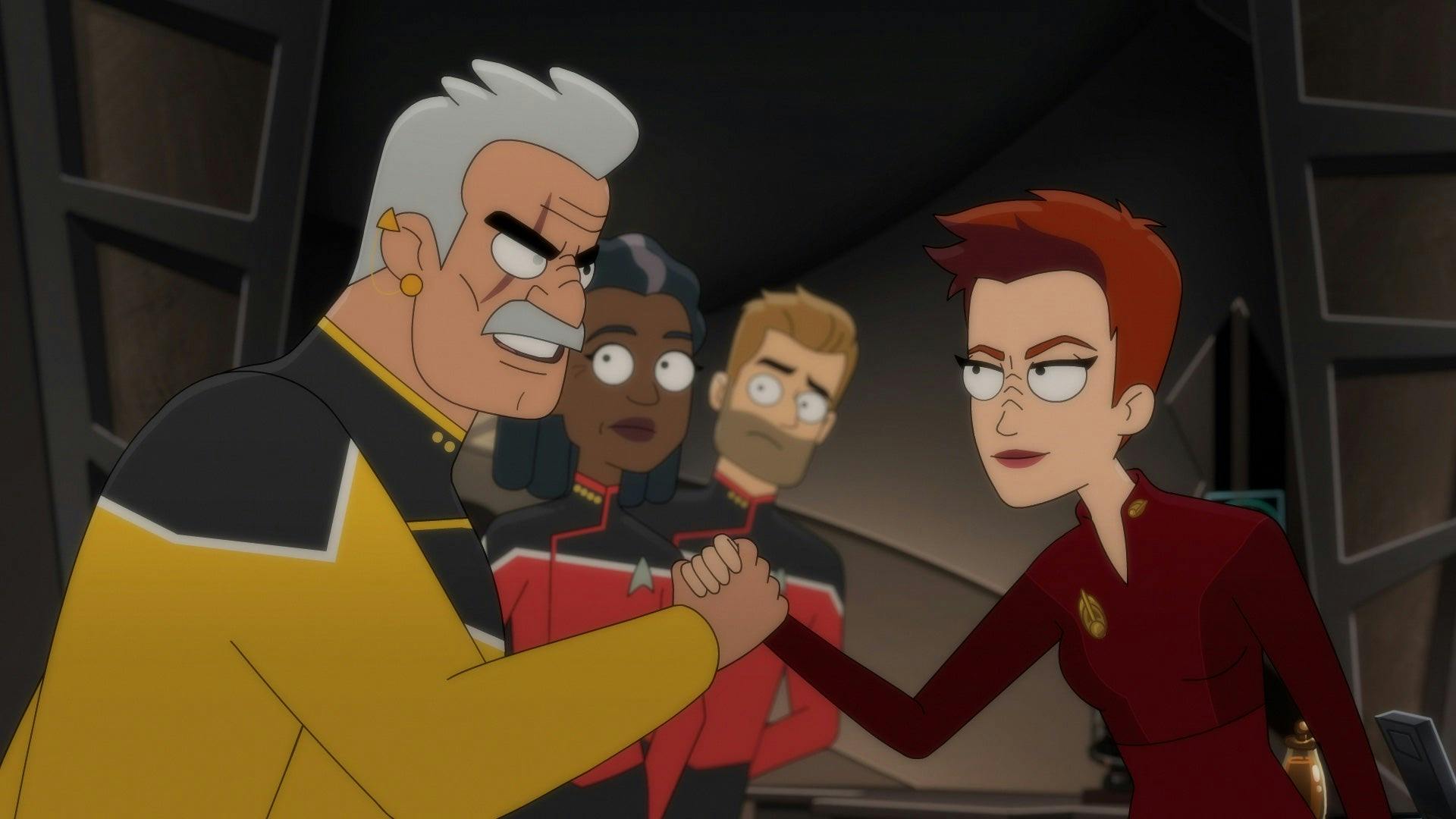
StarTrek.com
StarTrek.com: I have to admit, I'm a huge Deep Space Nine fan, so I got a little emotional as well when the music started playing.
Nana Visitor: I love that. It's pretty funny, right?
StarTrek.com: It's so funny. It might be one of my favorite jokes in the episode.
Nana Visitor: Me too.
StarTrek.com: How does the Kira Nerys that we see in this episode reflect the growth that she underwent over seven seasons on Deep Space Nine?
Nana Visitor: It's the same Kira that you see from the first year to the seventh year. It's this evolution of this being; there's really no difference. The values, the integrity, the problems, the weaknesses; they're all still there. It's just a matter of revisiting this person that we know.
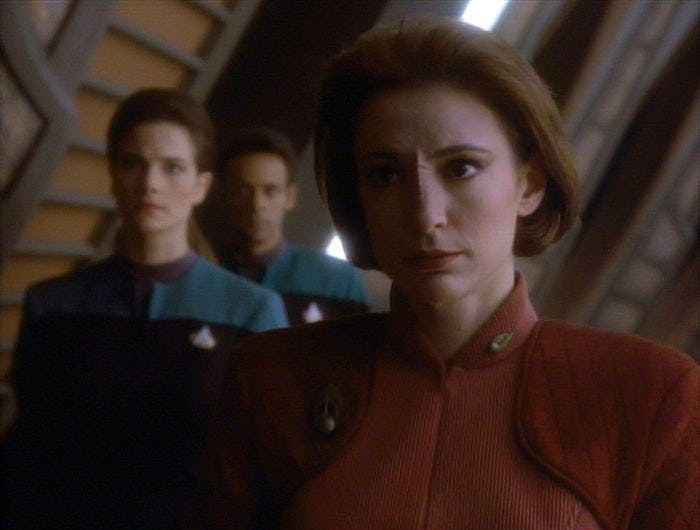
StarTrek.com
StarTrek.com: What was it like for you to get to play Kira again nearly 30 years after the show first debuted? Nana Visitor: To be honest, the answer is Kira's never left. I speak about her, or someone speaks to me about her, certainly every week, if not more. I hear what it meant in someone's life, and that causes me to reflect on how she influenced me, and she did a lot. She's always right off stage left for me, ready to walk on.
StarTrek.com: Kira is such a unique and powerful character. What do you think makes her such a force of nature in the Star Trek universe and what do you think makes her so beloved by the fans? Nana Visitor: What made her really disliked by a lot of people in the beginning, I think, is what's celebrated now. For a myriad of reasons, I got away with playing her as the kind of woman that I was so frustrated to play. A woman who had agency, who could change, who made mistakes and could still be a main character and learn from them and evolve.
I was so sick in the '90s of playing someone's girlfriend or dead girlfriend, wife or tortured wife, whatever it was; I didn't have access as a character to all the emotions. I had to respond to what the story needed me to tell of someone else's story. This was my opportunity to go full spectrum emotions, full spectrum of existence, and not play the cultural card, this performance quality of what a woman is supposed to be. Just having a few ridges on my nose gave me license to be the kind of human that I felt I was. And to have a sexuality and hungers and foibles, and not have to make it acceptable or reasonable so that I didn't upset anybody.
StarTrek.com: Characters like Kira in the earlier Star Trek shows have set the stage for the similarly powerful lead female roles of today's Trek, such as Mariner, Tendi, and Captain Freeman on Star Trek: Lower Decks. How do you feel knowing you're such an integral part of Star Trek's feminist legacy and their inclusive future? Nana Visitor: I am honored. I applaud these women, and I love that it's like we all open the iris just a little bit more. [We] just cracked it open a little bit so more light could shine out, or shine in, so that we could have the freedom to be not the kind of woman that was prescribed but the kind of women that we imagined and that we were. I feel a camaraderie. It's a circle, and not just with the women, but the men too. Not just the actors, but everybody who created Star Trek, who was in on this, the writers — Ira Steven Behr and it goes on and on. I'm even proud of when I watch For All Mankind. I go, "Yes!" Ron Moore [the showrunner of For All Mankind] was one of our writers and look what he's doing, oh my god, it's so great!
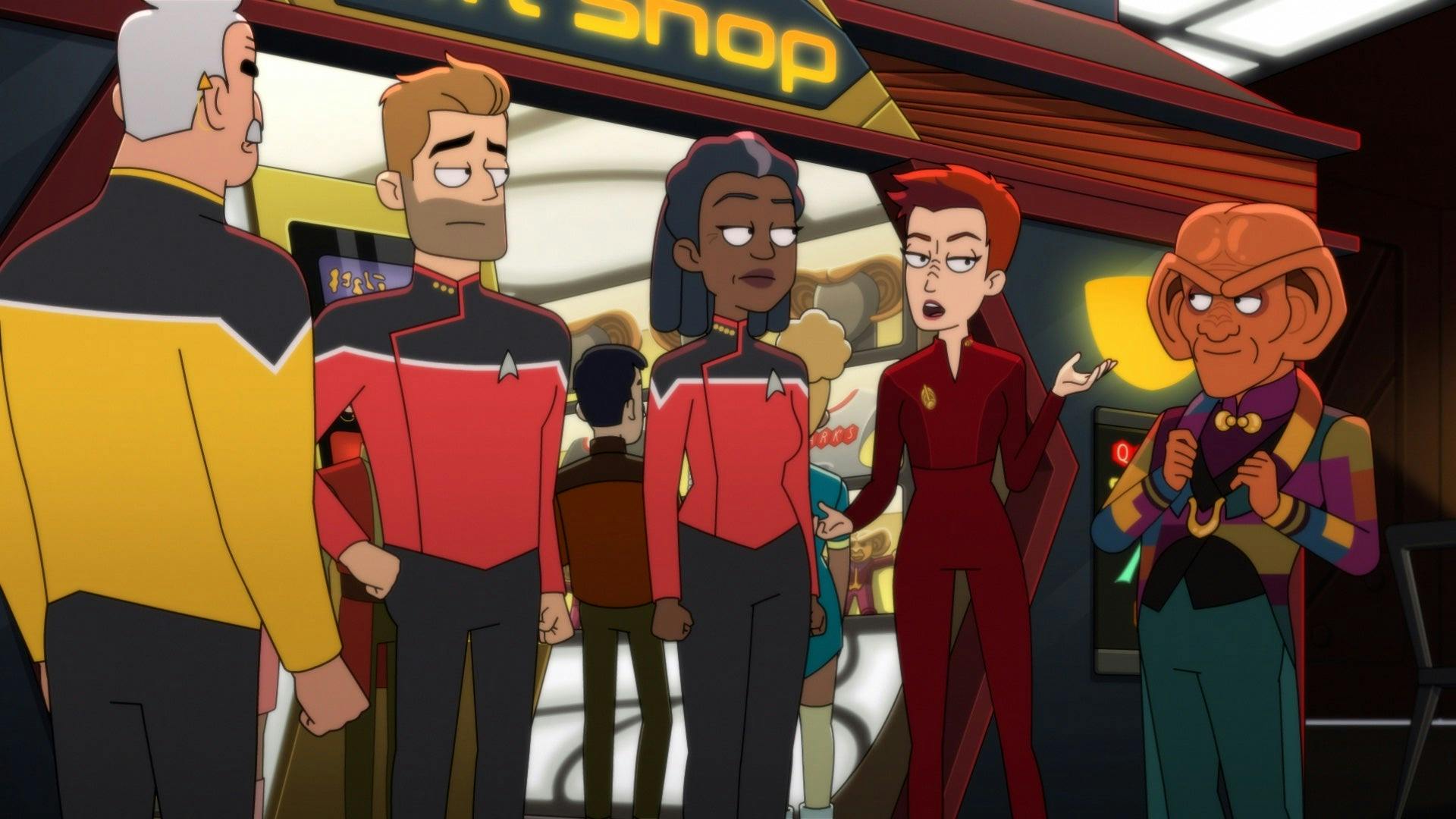
StarTrek.com
StarTrek.com: What was it like working with the cast and crew of Lower Decks?
Nana Visitor: Well, you're in a dark room and they are on-screens so it's a very virtual experience. I wasn't with the other actors, but this is very typical of voice work. The creativity comes in a very different way; as opposed to being a soldier in an army, suddenly it's guerrilla warfare and you're out there on your own. Anything can be used. You have to be creative, and you have to just take everything that's lobed to you and make something out of it. So, it's really interesting creative work and it's collaborative.
StarTrek.com: Deep Space Nine has become one of the most popular Star Trek shows. What does the fandom's embrace of Deep Space Nine mean to you and why do you think so many fans are drawn to it now more than ever?
Nana Visitor: Someone posted on Twitter a couple of years ago, "Hey, Deep Space Nine is trending. Why?" It slowly became obvious that people were really paying attention to the show years later. They got the idea that we were space stationed. We weren't taking the exploration out, but you have to watch it to get that we're taking the exploration in. That [the focus was] the interpersonal; the evolution of one entity. Kira evolves, she learns, she self reflects. People are more open to that [now].
The streaming platforms made it more accessible in terms of the serialization. That’s really the way it should have been watched in the beginning and people couldn't [because] people couldn't even find it. It would be preempted or moved; it's on a 12, or it's not on at all. It was very difficult to follow.
The whole story all still applies; we're still talking about these subjects that the writers delved into. I remember Armin [Shimerman] and I sitting on set and him saying, "You know what, in 25 years, people will get what we're doing. They don't get it now." I think that was true.
StarTrek.com: Deep Space Nine's 30th anniversary is next year. When you reflect back on the show's legacy, what jumps out at you?Nana Visitor: What jumps out at me, about what we did, was that we were able to keep people's attention, so that more could be made. I was listening to someone's speech about monarch butterflies. We used to think that they went from Canada to Mexico, and just traveled like that. We just recently found out that's not so. What happens is that there's several generations of butterflies that finally make it to their final destination in Mexico. It's heartbreaking that one butterfly group will die before they make it, but their children, they make the journey where they needed to be. The children make the next league of the journey until finally their destination is met. And I kind of feel that with DS9. We got to a place where it was good enough to make the next and the next and the next and hopefully, those stories keep coming.
StarTrek.com: That's such a beautiful way of putting things
Nana Visitor: You know what a group of monarch butterflies is called? It's so beautiful. A kaleidoscope. I think it should be a kaleidoscope of Star Trek actors. I kind of like that.
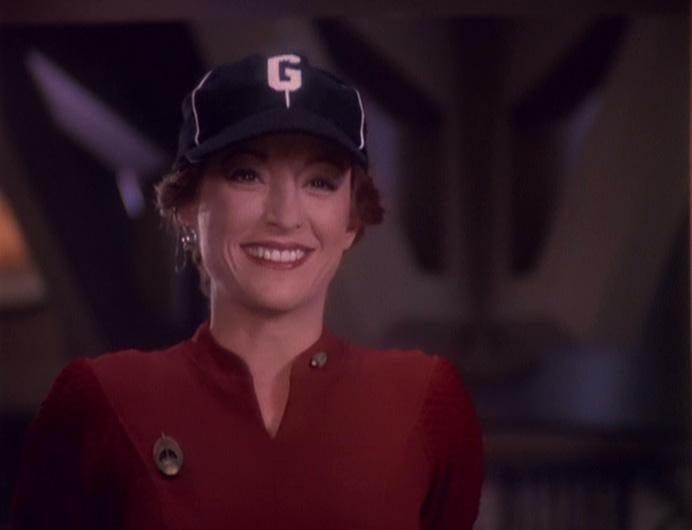
StarTrek.com
StarTrek.com: I agree. So, as more and more fans either revisit Deep Space Nine, or they watch it for the first time, what messages do you hope they take away from the series? Nana Visitor: I hope that what is projected is hope. That we are flexible, creative, and we adapt as humans. That's the power that we have, and we must use it. That diversity is a huge strength. This is what I appreciated about Deep Space Nine.
StarTrek.com: For my last question, what has been your favorite or one of your favorite memories of interacting with the Star Trek fandom? Nana Visitor: I'll tell you my favorite, and I'm flexing a little bit. No, actually, I'm flexing a lot. My favorite interaction was speaking to astronaut Samantha Cristoforetti, six months ago, while she was at ISA [International Space Station], and I was at ESA [European Space Agency], and when I heard [the person connecting us] say, "Open a channel to the space station," it almost blew me apart because that was a phrase I've said over and over, "Open a channel. Open a channel." And yet now, because Samantha watched the shows, because they were important to her, there was a channel being opened to an actual space station and I was talking to this astronaut. That almost blew me apart and I didn't exist after that. This interview has been edited and condensed.
Julian Gardner (they/them) is on the editorial team for StarTrek.com
Star Trek: Lower Decks streams exclusively in the United States and Latin America on Paramount+, and is distributed concurrently by Paramount Group Content Distribution on Amazon Prime Video in Australia, New Zealand, Europe, Japan, India and more, and in Canada on Bell Media’s CTV Sci-Fi Channel and streams on Crave.
Stay tuned to StarTrek.com for more details! And be sure to follow @StarTrek on Facebook, Twitter, and Instagram.

